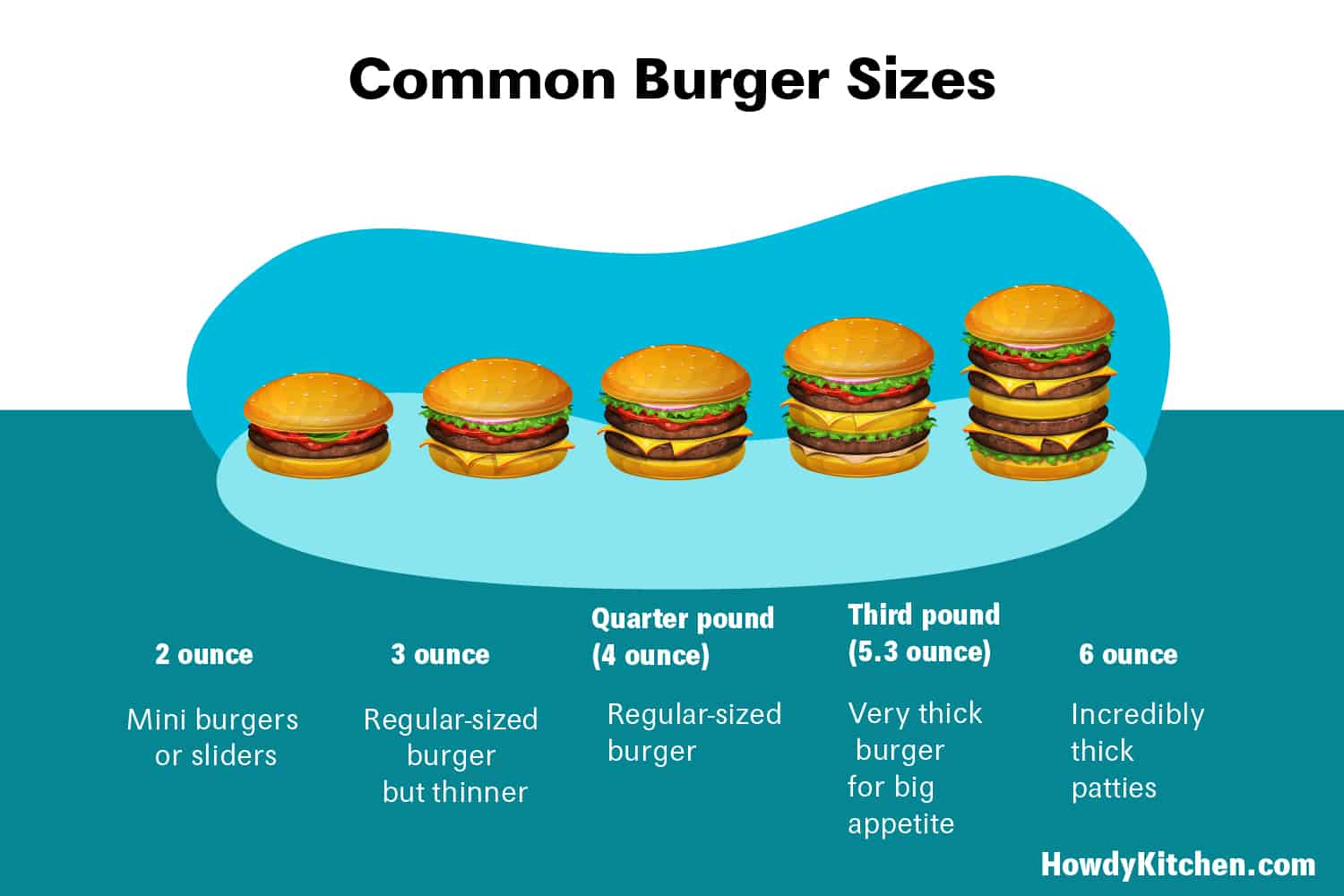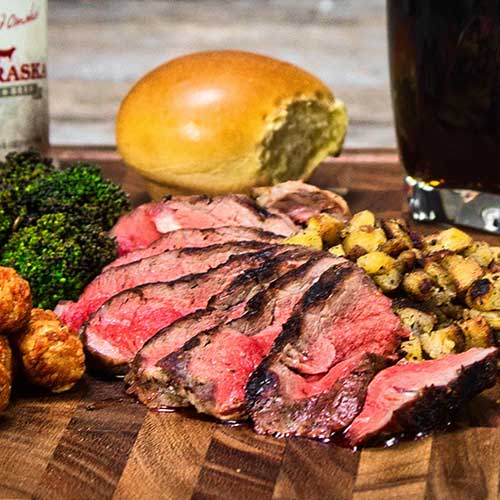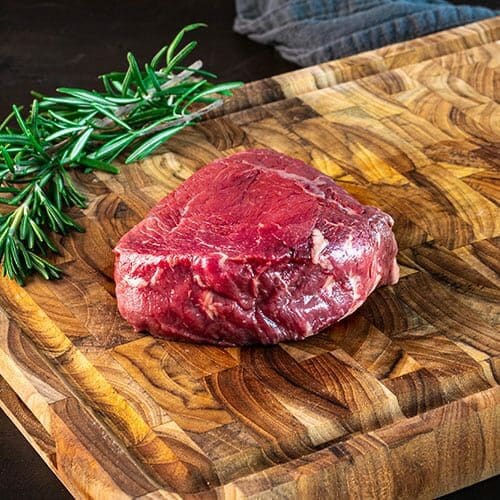These steaks are one of the best deals in the line. They don’t have any antibiotics or hormones and will not let you down. They are cut from lean Top Sirloin and average 1″ thick. They taste great when cooked slowly on the grill or for 10 to 12 minutes in the oven at 400 degrees. A quick, easy affordable dinner that you can serve to the most discriminating guests and still impress. NEVER THAW IN A MICROWAVE – this can damage the product. ALWAYS thaw frozen beef in the refrigerator or in a pan of cold water. DO NOT remove cryovac packaging until product is thawed completely.
The 10oz Top Sirloin is a steak that punches well above its weight class. The first question many people ask is, “how long should I cook it on each side?”…. There isn’t a single answer to that question because cook time depends on a lot of things, like the temperature of the steak at the beginning, the temperature of the grill surface, and the temperature of the room where the steak is being cooked. Beyond that, there is a simpler way that is more accurate. The internal temperature of the steak. It doesn’t really matter how the heat is applied; cooking heat can come from a wood fire, a broiler, or sous vide. There are literally dozens of great ways to cook a steak. Personally, we like our steaks “rare,” and for bigger cuts like the 10oz Top Sirloin, we take them off the heat when the internal temperature reaches 115 to 118F. The internal temperature will continue to coast up as the steak rests to somewhere in the 125-130F range. This is why giving the steak enough “rest time” after cooking is so important for making the perfect steak. The 10oz Top Sirloin is easy to cook because it’s fairly thick and doesn’t heat up as quickly as thinner steaks. This means it takes longer to reach the right temperature for serving.
Thaw slowly – submerge in a pan of cool water if you’re in a hurry, NEVER a microwave.
Season – Your preferred seasoning, to taste. Some people put oil on the steak before seasoning it, but we don’t think that’s the best way to do it and don’t suggest it.
Cook – Keep track of the internal temp, that’ll tell you when it’s done. Get a good digital thermometer.
Rest – 5 to 10 minutes is best. If you don’t cover the steak while it rests, it will stay warm. The “coast up” temperature will usually be higher than you want it to be.
Serve: Unless your guests are little kids or you like to be in charge, let them carve their own steak. Cutting a steak is part of enjoying a meal.
The 10oz Top Sirloin is a very versatile steak. It comes from the back of the “loin” part of the beef and has a great mix of taste and texture. Top Sirloin steaks are boneless, without exception. The Top Sirloin will exhibit some “marbling” but typically less than the Ribeye and NY Strip. When Top Sirloin steaks are aged correctly, they will be just as tender and tasty as NY Strip steaks. We cut our 10oz Top Sirloin steaks to approximately 1” thick. Because cattle are all different sizes, the steaks will be slightly different in thickness depending on the animal they came from. Many people ask us why the thickness of our steaks varies. The reason is that we cut our steaks to a certain weight, and since all cattle are slightly different sizes, the difference shows up in the thickness of the steak. If we cut all the steaks to the same thickness, then the weight of the steaks would vary…. which would greatly complicate selling them online.
All of our beef is “wet aged” which is a fairly common thing among beef producers. Still, our beef is wet aged for at least 35 days, which is longer than a lot of our competitors. This makes a difference in flavor and tenderness. When beef is wet-aged, enzymes that are already in the beef start to break it down and make it more tender. It has more effect on tenderness than it does flavor. Dry aging, on the other hand, is a very different process that uses the same naturally occurring enzymes to make the beef tender. Dry aging also lets the beef lose water, which tends to make the flavor stronger. One process called dry aging is a lot like aging artisanal cheese. The cheese tends to get stronger flavors that some people don’t like. We’ve found “wet aging” for an extended period to be the best case scenario for us.
Steak lovers rejoice! A juicy, flavorsome steak is one of life’s great pleasures. When ordering steak at a restaurant or buying it at the grocery store you’ll often see sizes listed in ounces. But what does that really mean in terms of the size of the steak? Specifically, how big is a 10 ounce steak?
In this article, we’ll break down exactly what you can expect from a 10 ounce cut of beef You’ll learn about popular 10 ounce steak options, dimensions, thickness, and how much meat is on the bone Let’s dig in!
What 10 Ounces of Steak Looks Like
Ten ounces of steak is a nice medium-sized serving, a bit bigger than a typical restaurant serving but not a huge mega-steak either. Here’s a quick list of what to expect from some common cuts of 10 ounce steak:
-
Ribeye – A 10 ounce ribeye is typically 1 inch thick and about 5 inches in diameter. It’s oval shaped with nice marbling and fat cap.
-
NY Strip: It’s about 4 inches wide and 6 inches long and is also 1 inch thick. Tender and juicy.
-
Filet Mignon – The leanest of the three, a 10 ounce filet is around 3.5 inches wide and 1.5 inches thick.
-
Sirloin – Fairly uniform in shape, approximately 1 inch thick and 4. 5 inches in diameter. Leaner than ribeye.
-
Flat Iron – Resembles flank or skirt steak, roughly 6-7 inches long and 4-5 inches at its widest point.
Average Dimensions of a 10 Ounce Steak
While dimensions vary slightly depending on the cut, here are the typical size stats for a 10 ounce steak:
- Diameter: 4 to 5 inches
- Length: 5 to 7 inches
- Thickness: 1 to 1.5 inches
- Surface area: About 16 to 25 square inches
A 10 ounce steak is substantial enough to make a satisfying meal for most people without an enormous appetite. The thickness provides plenty of juicy, tender meat.
How Thick is a 10 Ounce Steak?
For optimal flavor, texture and cookability, most 10 ounce steaks are cut to a thickness of about 1 to 1.5 inches. This allows the inside to cook to perfect doneness without overcooking the outside.
Here’s a breakdown of typical thickness for popular 10 ounce steaks:
- Ribeye – 1 inch
- Striploin – 1 to 1.25 inches
- Sirloin – 1 inch
- Filet Mignon – 1 to 1.5 inches
- Flat Iron – 3/4 to 1 inch
With proper cooking, a 1 to 1 1/2 inch thick steak allows you to achieve a nice crust on the surface while keeping the inside a perfect medium rare. Much thinner than 1 inch, and it overcooks too fast. Much thicker than 1.5 inches, and it’s harder to cook evenly throughout.
Accounting for Bone Weight
If you opt for a bone-in steak like ribeye or T-bone, some of the weight comes from the actual bone itself. For a 10 ounce steak, here is how much weight typically comes from bone:
-
Ribeye – Bone is 10-15% of total weight, so 1.5 to 2 ounces.
-
T-bone – Bone is around 20% of weight, so about 2 ounces.
-
Porterhouse – Large T-bone, bone is 1.5 to 2.5 ounces of a 10 ounce steak.
So you’ll get around 8 to 8.5 ounces of edible meat from a 10 ounce ribeye or T-bone steak. The bone adds flavor during cooking but most people don’t eat it.
Is 10 Ounces Enough for One Person?
Whether a 10 ounce steak is enough per person depends on the meal context:
-
As a standalone main course with sides, 10 ounces is likely too much for one average eater. An 8 ounce steak is more reasonable.
-
As part of a larger buffet or multi-course meal, 10 ounces may be suitable. Allow 2-4 ounces per person.
-
For big appetites, active men, or those who love leftovers, 10 to 12 ounces is a satisfying single portion.
-
If serving bone-in steaks, allow 12-14 ounces per person to account for bone weight.
In general, we recommend about 1/2 pound, or 8 ounces, of steak per average eater. But adjust portions based on your diners and overall meal.
Cooking a Perfect 10 Ounce Steak
A 10 ounce cut is a great steak choice. Follow these tips for cooking it to juicy, tender perfection:
-
Let it come to room temp before cooking for even heating.
-
Season well with salt (kosher is best) 40 minutes prior to cooking.
-
Pat extremely dry with paper towels – this helps get a nice sear.
-
Preheat a heavy pan until very hot before adding steak.
-
Sear 2-4 minutes per side, until browned.
-
Use a meat thermometer to test doneness, removing it from heat at 10°F below target temp.
-
Rest 5+ minutes before slicing into it.
The Takeaway
A 10 ounce steak offers a nicely substantial portion of delicious, well-marbled beef. It provides a good balance between having enough meat to sate your appetite while avoiding a comically huge steak. For most diners, 10 ounces is just right for a satisfying meal.
With the right thickness, seasoning and searing, you can achieve a perfect 10 ounce steak cooked to your desired doneness. Understanding steak sizes will help you pick the right cuts of beef and portions to suit any meal.

Slab Jerky5oz Bags 3oz Bags
Signature® Salt + Pepper
Signature® Universal (Lower Sodium)
Signature® SPG (Salt, Pepper, Garlic)
Signature® BBQ Dry Rub
Signature® Horseradish Prime Rib Rub
Soup & Beef Bundles
Stacy Lynn’s Cinnamon Rolls




$24.99 – $159.99 — or subscribe and save up to 10%
| Select Quantity: No selection | Clear |
|---|
No antibiotics, growth hormones or steroids added.
These steaks are one of the best deals in the line. They don’t have any antibiotics or hormones and will not let you down. They are cut from lean Top Sirloin and average 1″ thick. They taste great when cooked slowly on the grill or for 10 to 12 minutes in the oven at 400 degrees. A quick, easy affordable dinner that you can serve to the most discriminating guests and still impress. NEVER THAW IN A MICROWAVE – this can damage the product. ALWAYS thaw frozen beef in the refrigerator or in a pan of cold water. DO NOT remove cryovac packaging until product is thawed completely.
| Weight | 10 oz |
|---|
The 10oz Top Sirloin is a steak that punches well above its weight class. The first question many people ask is, “how long should I cook it on each side?”…. There isn’t a single answer to that question because cook time depends on a lot of things, like the temperature of the steak at the beginning, the temperature of the grill surface, and the temperature of the room where the steak is being cooked. Beyond that, there is a simpler way that is more accurate. The internal temperature of the steak. It doesn’t really matter how the heat is applied; cooking heat can come from a wood fire, a broiler, or sous vide. There are literally dozens of great ways to cook a steak. Personally, we like our steaks “rare,” and for bigger cuts like the 10oz Top Sirloin, we take them off the heat when the internal temperature reaches 115 to 118F. The internal temperature will continue to coast up as the steak rests to somewhere in the 125-130F range. This is why giving the steak enough “rest time” after cooking is so important for making the perfect steak. The 10oz Top Sirloin is easy to cook because it’s fairly thick and doesn’t heat up as quickly as thinner steaks. This means it takes longer to reach the right temperature for serving.
Order of operations:
Thaw slowly – submerge in a pan of cool water if you’re in a hurry, NEVER a microwave.
Season – Your preferred seasoning, to taste. Some people put oil on the steak before seasoning it, but we don’t think that’s the best way to do it and don’t suggest it.
Cook – Keep track of the internal temp, that’ll tell you when it’s done. Get a good digital thermometer.
Rest – 5 to 10 minutes is best. If you don’t cover the steak while it rests, it will stay warm. The “coast up” temperature will usually be higher than you want it to be.
Serve: Unless your guests are little kids or you like to be in charge, let them carve their own steak. Cutting a steak is part of enjoying a meal.
The 10oz Top Sirloin is a very versatile steak. It comes from the back of the “loin” part of the beef and has a great mix of taste and texture. Top Sirloin steaks are boneless, without exception. The Top Sirloin will exhibit some “marbling” but typically less than the Ribeye and NY Strip. When Top Sirloin steaks are aged correctly, they will be just as tender and tasty as NY Strip steaks. We cut our 10oz Top Sirloin steaks to approximately 1” thick. Because cattle are all different sizes, the steaks will be slightly different in thickness depending on the animal they came from. Many people ask us why the thickness of our steaks varies. The reason is that we cut our steaks to a certain weight, and since all cattle are slightly different sizes, the difference shows up in the thickness of the steak. If we cut all the steaks to the same thickness, then the weight of the steaks would vary…. which would greatly complicate selling them online.
All of our beef is “wet aged” which is a fairly common thing among beef producers. Still, our beef is wet aged for at least 35 days, which is longer than a lot of our competitors. This makes a difference in flavor and tenderness. When beef is wet-aged, enzymes that are already in the beef start to break it down and make it more tender. It has more effect on tenderness than it does flavor. Dry aging, on the other hand, is a very different process that uses the same naturally occurring enzymes to make the beef tender. Dry aging also lets the beef lose water, which tends to make the flavor stronger. One process called dry aging is a lot like aging artisanal cheese. The cheese tends to get stronger flavors that some people don’t like. We’ve found “wet aging” for an extended period to be the best case scenario for us.
How much Protein in Beef cooked? (You’re probably not measuring correctly!)
FAQ
Is 10 oz of steak enough for 2 people?
How many servings is a 10 oz steak?
|
Package size: 10 oz.
|
|
|
|
Serving Size: 4 oz., cooked, fat trimmed
|
|
|
|
Servings per package: 5
|
|
|
|
|
|
Daily Value %
|
|
Calories
|
188
|
|
How big is a 12 oz steak?
What is a good size steak?
What is a 1 oz serving of meat?
A standard 1 oz serving of meat is generally equivalent to the size of a small matchbox or the palm of your hand. To visualize this, imagine a slice of deli meat about the size of a slice of bread, or a single chicken tenderloin. Additionally, a 1 oz portion of ground meat, such as beef or turkey, is roughly the size of a golf ball.
How big is a 10 oz steak?
A 10 oz steak is a pretty big steak. It’s enough to feed one or two people if you’re sharing. The average 10 oz steak is about 9-10 inches in diameter and 1-2 inches thick. So if you’re looking for a hearty meal, a 10 oz steak is a good choice. Is 10 Oz Steak Small? A ten-ounce steak is on the smaller side as far as steaks go.
What does 1 oz of meat look like?
In this section, we will explore visual comparisons to help you understand what 1 oz of meat looks like. A standard 1 oz serving of meat is generally equivalent to the size of a small matchbox or the palm of your hand. To visualize this, imagine a slice of deli meat about the size of a slice of bread, or a single chicken tenderloin.
What is the size of a 5 oz steak?
A 5 oz steak is a smaller size, measuring around 0.75 inches to 1 inch in thickness. It is thinner than an 8 oz steak.
